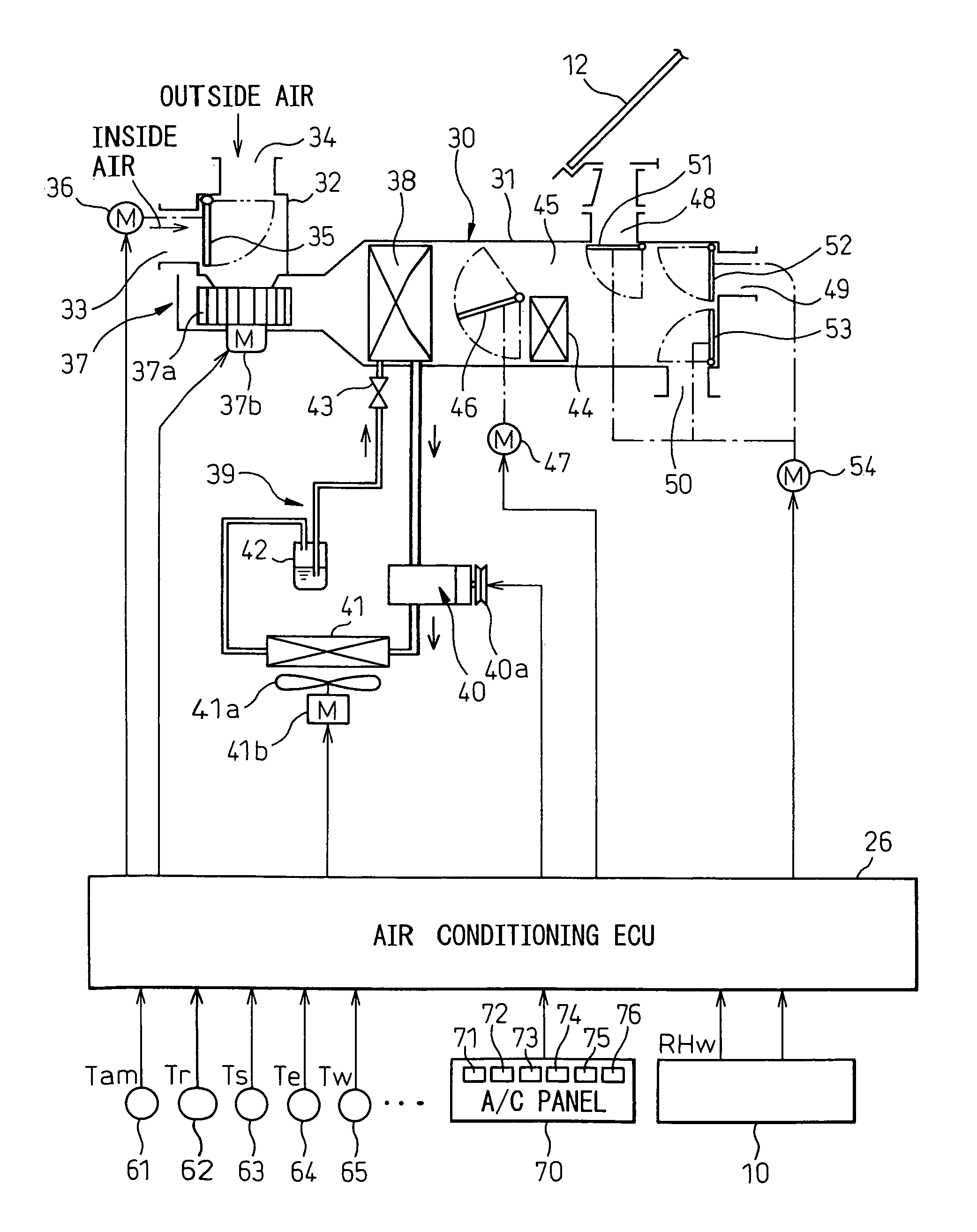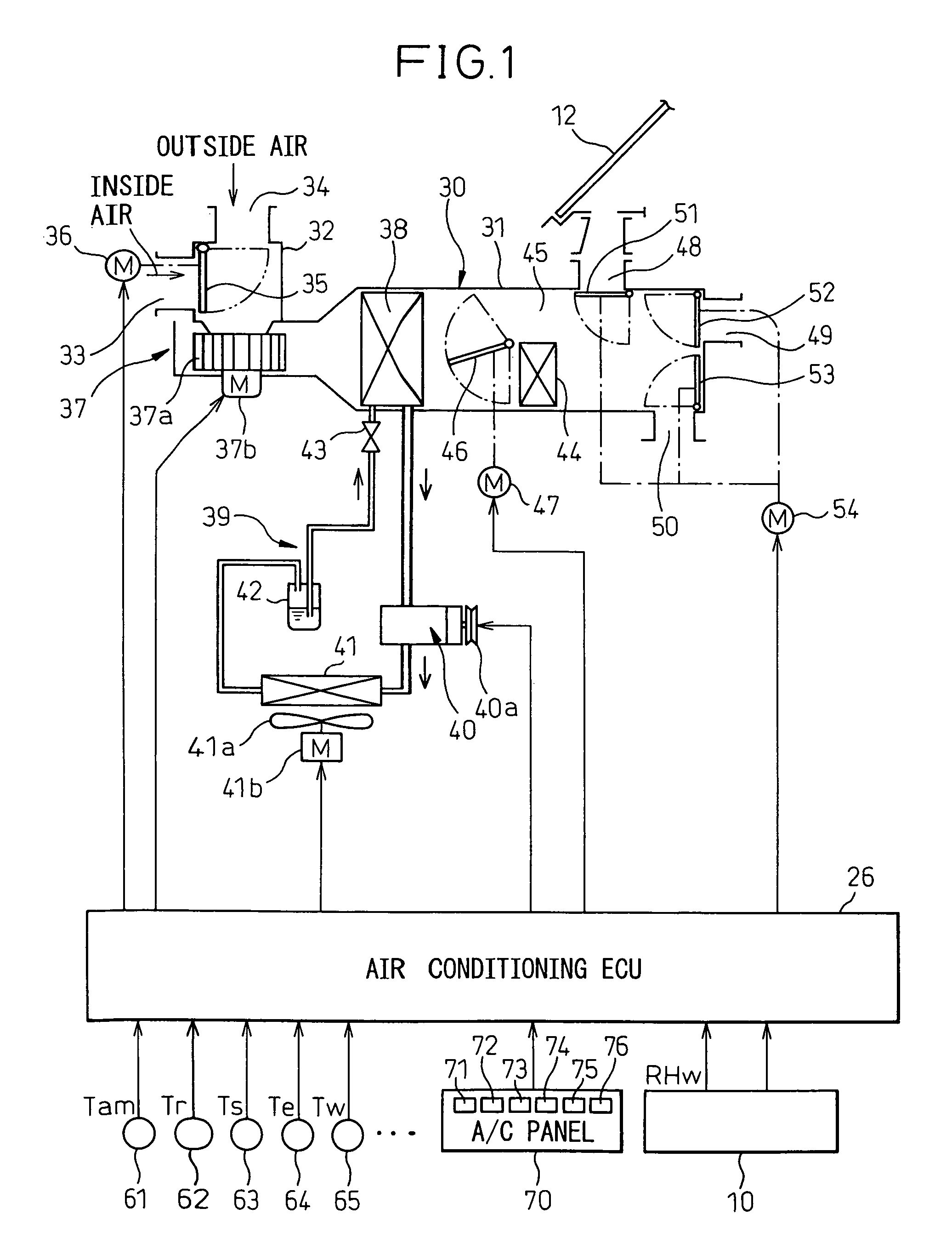Vehicular air-conditioner
a technology for air conditioners and vehicles, applied in the direction of humidity control, refrigeration components, ratio control, etc., can solve the problems of insufficient heating capacity, immediate rise of humidity in the vehicle compartment, impaired passenger comfort, etc., to suppress the fogging of the window glass and suppress the drop in heating capacity
- Summary
- Abstract
- Description
- Claims
- Application Information
AI Technical Summary
Benefits of technology
Problems solved by technology
Method used
Image
Examples
first embodiment
[0052]FIG. 1 shows the schematic configuration of a vehicle air-conditioner according to a first embodiment of the present invention.
[0053]The vehicle air-conditioner has an inside air-conditioning unit 30 arranged behind an instrument panel at the front most part of a passenger compartment. This inside air-conditioning unit 30 has a case 31. Inside the case 31, an air passage is formed for blowing air toward the inside of the vehicle compartment.
[0054]At the upstream most part of the air passage of the case 31, an inside / outside air switching box 32 is provided. An inside air introduction port 33 and an outside air introduction port 34 are able to be switched to open and close by an inside / outside air switching door 35. This inside / outside air switching door 35 is driven by a servo motor 36.
[0055]At the downstream side of the inside / outside air switching box 32, an electrically powered blower 37 is provided for blowing air toward the inside of the vehicle compartment. This blower 3...
second embodiment
[0162]When the engine water temperature is low at the initial start of a heating operation, the heater core 44 may not sufficiently warm the air-conditioning air, cool air may be blown out from the blowing ports 48 to 50, and the passengers may be discomforted as that cool air strikes them.
[0163]Therefore, as shown in FIG. 15, in the related art, when the engine water temperature is low, after the start of a heating operation, the air-conditioning use electrically driven blower 37 is stopped for a certain time until the engine water temperature reaches a certain temperature (33° C.) or more, then the air-conditioning use electrically powered blower 37 is started. By doing this, cool air is prevented from striking the passengers.
[0164]However, when the air-conditioning use electrically powered blower 37 is stopped, the respiration of the passengers causes the humidity in the vehicle compartment to rise and the window glass ends up fogging up. On the other hand, as shown in FIG. 16, i...
third embodiment
[0170]In the first embodiment, one of the control modes 10 to 60 was selected as the defrost control based on the window glass surface relative humidity RHW and the blowing mode was determined along with this selection, but at the initial start of the heating operation when the engine cooling water is low in temperature, cool air is blown out from the blowing ports. At this time, if cool air is directly blown from the face blowing port 49 and the foot blowing port 50 to the passengers, the passengers will sometimes be discomforted.
[0171]Therefore, in the third embodiment, as shown in FIG. 19, when the temperature of the engine cooling water is less than 33° C., the defrost mode is selected. After this, when the temperature of the engine cooling water rises and becomes higher than 38° C., one of the control modes 10 to 60 is selected as shown in FIG. 12 based on the window glass surface relative humidity RHW and the blowing mode is selected along with that selection. That is, the blo...
PUM
| Property | Measurement | Unit |
|---|---|---|
| dielectric constant | aaaaa | aaaaa |
| humidity | aaaaa | aaaaa |
| temperature | aaaaa | aaaaa |
Abstract
Description
Claims
Application Information
 Login to View More
Login to View More - R&D
- Intellectual Property
- Life Sciences
- Materials
- Tech Scout
- Unparalleled Data Quality
- Higher Quality Content
- 60% Fewer Hallucinations
Browse by: Latest US Patents, China's latest patents, Technical Efficacy Thesaurus, Application Domain, Technology Topic, Popular Technical Reports.
© 2025 PatSnap. All rights reserved.Legal|Privacy policy|Modern Slavery Act Transparency Statement|Sitemap|About US| Contact US: help@patsnap.com



